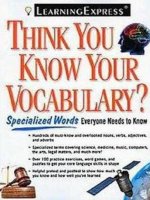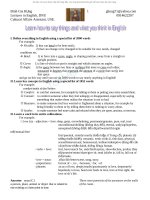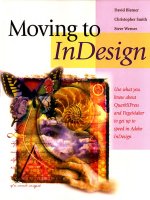Knowing What You Know
Bạn đang xem bản rút gọn của tài liệu. Xem và tải ngay bản đầy đủ của tài liệu tại đây (69.99 KB, 8 trang )
51
CHAPTER
7
K
NOWING
W
HAT
Y
OU
K
NOW
What makes you say,
“Now I get it!” or “I see
what you mean”? You have
learned something—
whether it’s parallel
parking a car or
understanding terms in a
psychology class—when
you know that you
know it.
K
nowing something and knowing that
you know something are two different things. You may know
things you don’t know you know—odd little facts lying
around in your head like Ted Williams’ batting average or the phone
number of your childhood home. On the other hand, you can think you
know something that you don’t really know, like the contents of that
chapter you read or lecture you heard but didn’t think about afterwards.
To study effectively, you have to realize what you don’t really know. It is
then that you will develop an awareness of your knowledge and learn-
ing processes.
What Is Awareness?
Shirley read the assigned lesson on thinking for her psychology
class. She felt she knew the material she studied. Yet, in class
when the instructor started talking about cognition, she felt
lost. She looked at Charlene sitting next to her, and whispered,
“I don’t remember reading about that!” “It’s here, on page 27,”
Charlene answered, showing Shirley the textbook. Shirley asked
Charlene after class, “How could I think I understood something,
when I didn’t?”
Charlene laughed, “That’s just what the lesson was about—
needing awareness so you know when you know, and know
when you don’t.” Shirley shook her head, “I felt really involved
reading about the experiments with the monkey in the beginning
of the lesson. I guess I just skimmed over the rest of the reading,
so I thought the whole lesson was on the monkey. It’s obvious that
I didn’t read it carefully enough.”
HOW TO STUDY
52
It is not easy to develop awareness. You must bring up to the level
of consciousness things you’ve more or less taken for granted, things you’ve
let lie low. Awareness is like a cog in the machinery of the brain, because it
helps you move and connect other information. Another word for aware-
ness is cognition. Cognition is knowing when you know something.
BUILDING AWARENESS
Realizing exactly how you go about mentally processing what you read
and hear may not come naturally to you. It’s difficult because reading
and hearing are things people do automatically. For example, someone
wouldn’t say to himself, before opening a book, “I’ll open this book now
and turn to the page where I left off last time. Then I’ll move my eyes
across and down each page until I get to the end of this lesson....”He
just does it.
How do you know when you know something? How do you know
for sure? How do you know, for example, that one plus one equals two?
You might say, “Of course, I know it!” But—how do you know you
know it?
KNOWING WHAT YOU KNOW
53
Use your own learning styles to build an awareness of what
you know:
• If you learn best by seeing: You might say,“Here’s one pencil, and
here’s another pencil. I can see there are two pencils.”
• If you learn best by hearing: You might say, “Here’s the sound of
one pencil making a tap on the table, and here’s the sound of a
second pencil tap. I hear two taps.”
• If you learn best by images: You might say, “I know one plus one
makes two because I picture one pencil and then the other and I
see that there are two.”
• If you learn best by ordering things: You might say, “The order
is right. I know that I start with two individual pencils and end up
with a pair.”
• If you learn best by doing: You might pick up one pencil and pick
up another, and say, “I see them, I feel them. Here they are, one
plus one equals two.”
There can be many different ways to know that you know; you just
have to figure out which way is yours.
PUTTING AWARENESS TO THE TEST
It’s one thing to think you know, and another to actually know. Test your-
self to find out how well you know something you are studying.
S
EEING
I
S
B
ELIEVING
One way you know something is by seeing it in your head. Using images
to reconstruct what you brought away from chemistry class, a good
movie, or a dance recital comes naturally for many people. Charlene, who
we met in the beginning of this chapter, knows she learns well using
images. Read on to see how she made sense of the cognition chapter.
1.
2.
3.
HOW TO STUDY
54
Charlene checked to see that she knew what she thought she knew by
drawing a picture of her study material. Since the images that came to her
mind were so clear she could draw a detailed and coherent picture, she was
able to say, “I know that I know this because the pictures are clear in my
head.”
M
AKING
O
RDER
Another way to test your understanding of what you’ve studied is to review
the order of events. Charlene also used an order-oriented approach to sup-
plement her picture:
Charlene listed events and drew a timeline to demonstrate what she
absorbed from studying. This helped her notice where the part about the
monkey ended and the definition of cognition began. She was able to say,
“I know that the subject is changing because there is a clear sequence of
events.”
T
HE
Q
UEST FOR
Q
UESTIONS
Another way to check yourself is to come up with questions. Charlene
was an extremely thorough student, and ended up answering all her own
questions.
Charlene came up with several questions based on her picture and
timeline. She then went back to her text and answered those questions
and changed her picture and timeline until they were both clear. Then,
when she had no more questions, she was sure she knew the material. At
that point, the picture and the timeline were clear in her mind, the order
of events was clear, and the timeline and picture were obviously related.
Then she was able to say, “I get it!”
BUILDING ON WHAT YOU ALREADY KNOW
Thinking about what you’ve read or listened to helps you identify what
you know, and this helps you make sense of what you studied. When you
can connect new material to things you already know, you learn the
material faster and remember it longer.
The best way to make connections between new and old
material is to use your learning styles. Use the ideas below to build on
what you already know. The more connections you make between and
within topics, the more coherent your study material will become.
KNOWING WHAT YOU KNOW
55
• If you learn best by seeing: Compare old notes to new notes;
look for common words and phrases, and make connections
between ideas.
• If you learn best by hearing: Read your notes aloud. Listen for
familiar words and phrases. Where have you heard them before?
• If you learn best by making images: Draw pictures or maps of
what you see when you study. Do these images bring to mind|
something you’ve learned in the past?
• If you learn best by order: First review old material and then take
a look at a new assignment in the same subject. Make a timeline
or list of events starting from the old material and working
through the new. See how things progressed, or didn’t.
• If you learn best by doing: Role play. If you’re reading a novel, act
out the part of the hero or heroine. Does that character remind
you of anyone you know? This familiarity could help you write
your essay.
As you try one or more of these methods, are you aware of how you
are studying? Think, write, or talk about it.
D
ISCOVERING THE
F
AMILIAR
Here’s a sample version of how you can use what’s familiar to help you
learn and remember something that’s unfamiliar.
• Skim through a page of a text you’re studying or a newspaper and
find a word that’s new to you—for example, the word crumpet.
• Find parts of that word you already know: crum and pet or et.
• In your notebook, write down other words that have the same
letters as those in the parts you’ve identified: crumb and petty.
• What similar meaning is in your list of words? You might say that
crumb is a small piece of food and petty describes something that
doesn’t matter very much.
Try It!
1.
2.
3.









